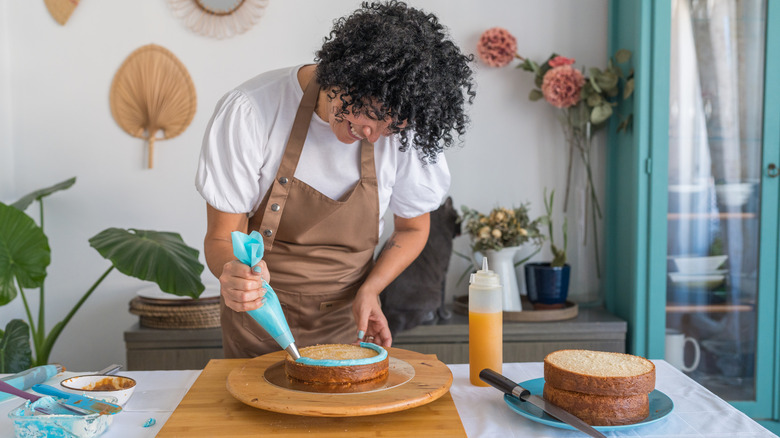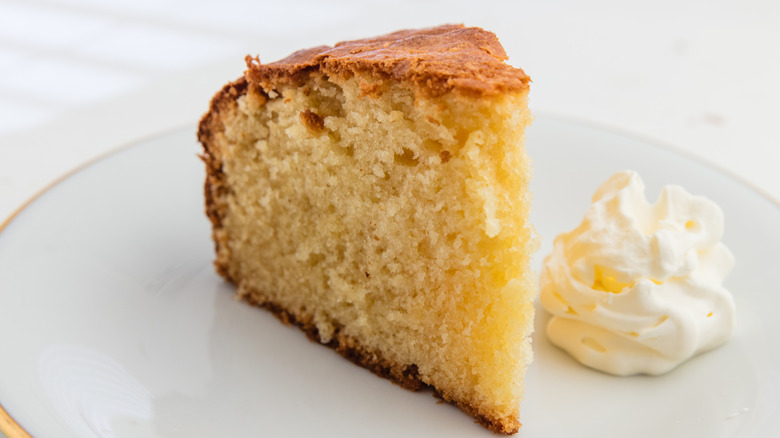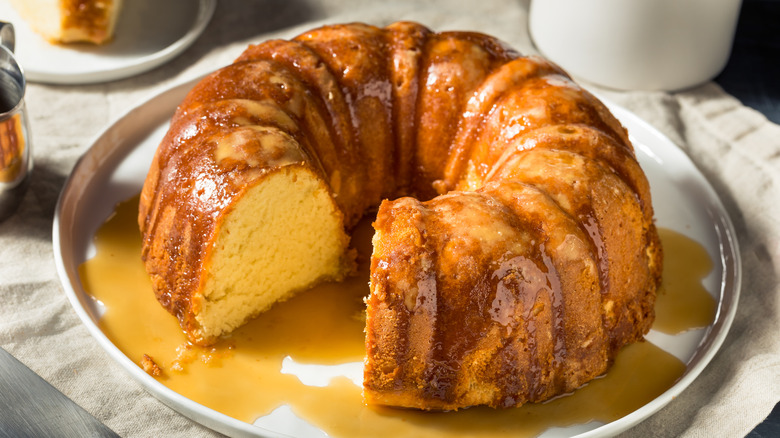Butter Cake Vs Pound Cake: What's The Difference?
If you're into baked goods, chances are you've come across both butter and pound cakes. These timeless loaf-shaped (and occasionally bundt-shaped, especially in the case of pound cakes) classics are rich, buttery, and incredibly easy to bake — perfect for amateur bakers who are looking to master the basic building blocks. While they may seem almost identical at first glance, with both having golden brown tops and a strong butter base, there are some key differences that set them apart. To clear the confusion, Food Republic spoke with expert David Davidov – recipe developer and creator of The Cooking Foodie – who explained that the main distinctions between the two comes down to their texture, baking methods, and ideal uses.
"Pound cake is dense and rich, ideal for slicing and pairing with fruit or tea. Butter cake is soft, airy, and often layered or frosted," Davidov told us. So whether you're prepping for a birthday, craving a baked treat, or simply in the grocery store and unsure which one to buy, knowing the different characteristics of each cake will help you pick the right one for your taste preferences.
What is a butter cake?
While both butter and pound cakes start with the same pantry staples that every home-baker should have in their kitchen arsenal – softened butter, sugar, eggs, and flour – It's the proportion of the these ingredients and the inclusion of leavening agents that make butter cakes distinct from pound cakes: "Butter cake tends to have more sugar and liquid (milk, buttermilk, or sour cream) relative to the fat and flour, plus baking powder or soda for a lighter texture," David Davidov told us. The larger amount of liquids and sugar are what give butter cakes their signature sweet, moist texture that melts in your mouth, while the leavening agents create a light and airy crumb with more volume than a traditional pound cake. For additional moisture, consider using these 12 baking hacks next time you're whipping up a butter cake.
Thanks to their fluffy texture, Davidov explained, butter cakes are the preferred option for decorating: "Butter cakes are the go-to for birthdays, celebrations, and frosted layer cakes. They're designed to hold up to fillings and buttercream, and their lighter texture makes them crowd-pleasers for most palates." It's rich, buttery taste creates a balanced flavor that pairs well with most frostings. The soft yet sturdy texture makes it especially well suited for layered cakes, offering both delicious taste and a reliable structure. With their simple, adaptable flavor profile, butter cakes can be served with a variety of icings and fillings, like a buttercream frosting blended with sweet condensed milk – aka Russian buttercream.
What is a pound cake?
The iconic pound cake takes a no-fuss approach to baking. It gets its name from the fact that it's traditionally made with a pound of the four main ingredients: flour, butter, eggs, and sugar. This ingredient ratio "creates a dense, fine-crumbed cake that's sturdy and rich," David Davidov told us. This old-fashioned recipe traditionally does not use leavening agents, and instead relies on the air incorporated during the creaming of the batter and sugar, rather than baking powder and baking soda. Its higher ratio of butter and eggs to flour, and lack of leavening agents, give it a dense, compact structure alongside a very rich buttery texture.
The rich, dense crumb and delicate flavors of pound cakes mean that frosting would be wasted on them. One of the most appealing things about pound cakes is that their base flavor can stand alone without any extra pizzazz, and traditionally, the most popular flavorings to the cake itself are vanilla, coconut, rum, butter, and lemon. One way to make the freshest of lemon pound cake is to pour lemon juice on the dessert, right when it comes out of the oven.
As Davidov put it: "It's simple, but when done right, it's elegant." He added, "Pound cake is perfect for casual or elegant occasions where the cake stands on its own — think afternoon tea, brunches, or served with macerated berries and whipped cream. It travels well and keeps beautifully." If you're looking for unfrosted yet inventive upgrades for your pound cakes, try having a go at using Ina Garten's sugar technique for a crackly crust



